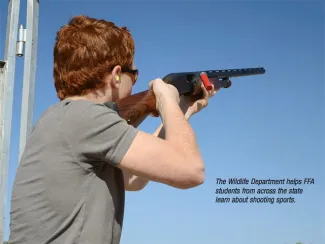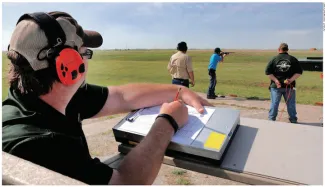
Hunting, fishing, and hiking are just a few of the many outdoor activities that are popular throughout Oklahoma and the United States. But we should add another to the list, so to speak, of very popular and rewarding outdoor activities: shooting sports.
The wealth of disciplines included in shooting sports includes trap, skeet, sporting clays and five-stand, all done with a shotgun, as well as target shooting and silhouette shooting with rifles. And let’s not forget target shooting with pistols, and the more demanding discipline of action shooting, where competitors use different firearms in a timed setting to score as many points as possible. Those who engage in the various shooting sports have long surpassed the childhood activity of “plinking” (which for me was shooting soda cans in the pasture with my grandfather). Some shoot for the fun of it, while others take the competition quite seriously, even hoping for a chance to go to the Olympic Games. The popularity of shooting sports is such that Oklahoma has more than 180 public schools involved in the Oklahoma Scholastic Shooting Sports Program (OKSSSP), a trap-based program started in 2013 by the Oklahoma Department of Wildlife Conservation (ODWC).
Students at these schools, from 7th grade through 12th grade, compete in regional events with the hope of advancing to the annual state shoot, which has been held each spring at the Oklahoma Trap and Skeet Association in El Reno, Okla. Of the 180-plus schools that begin regional competition each spring, the top 16 senior teams and top eight junior teams advance to the state shoot. “This program is amazing,” said Damon Springer, Senior Information and Education Specialist with ODWC, and coordinator of OKSSSP. “These kids really enjoy this program, and it promotes firearms safety as well as healthy competition. Many of them have even gone on to earn scholarships to be on a shooting team at the college level.” Schools wanting more information about OKSSSP may call Springer at (405) 317-6316.

For some, shooting sports have been a part of their lives forever. For others, the introduction comes later in life but has had a profound impact. Suzi Rouse, president of Oklahoma City Gun Club, is one such example. While her father and two brothers went on hunting trips, Rouse and her sister were left behind.
“It was not even an option of introducing us, because we were girls,” Rouse said. After meeting the man who would become her husband — a U.S. Marine Corps veteran — she joined him in becoming a member of Oklahoma City Gun Club (OKCGC). Rouse’s activity and involvement grew so much, she was approached in 1999 about starting a women’s program, and the gun club began hosting an annual Women on Target event each September. This year will mark the 21st event. The event draws as many as 600 women from across the country, many of whom plan their vacation time around the event and are repeat visitors. During the daylong event, they have the opportunity to target shoot with rifles and pistols, as well as shoot moving clay targets with shotguns. “It empowers them. They feel like they can accomplish something,” said Rouse, who has been president of OKCGC for 12 years.
A similar background belongs to Paula Tate, an active skeet shooter at OKCGC and a former chairman of the club’s Shotgun Division. Tate grew up watching her father and brother venture off to hunt, and it wasn’t until 2007 that she attended her first Women on Target event. Tate and her husband, Brent, remain very active with the club. Both of them shoot competitively, and both serve as instructors at a variety of events. For Adam Dreyer, also an OKCGC member, becoming involved in shotgunning activities was delayed only by his age. Dreyer, a native of Illinois, moved to Edmond with his parents on his 8th birthday. It would be two more years before he picked up a shotgun, but it wasn’t for a lack of desire. “I started doing the 4-H archery and air rifles, and I had to wait until I was 10 to do shotguns,” he said. “And ever since then, I’ve been doing shotgun sports.” Dreyer has been actively involved in all shotgun disciplines, with his main focus being skeet. He is also an avid duck hunter. Dreyer has had to dial back on his level of skeet shooting while pursuing his education at Oklahoma State University. Majoring in wildlife ecology and management, he hopes to one day serve as a game warden with ODWC. For those new to shooting sports, Dreyer offers this advice: It takes time, practice, and patience. “If they try it and they are not successful at first, don’t be discouraged,” he said. “It takes a lot of muscle memory and practice to get to where you really start to enjoy it.” Dreyer said shooting sports are about skill, not athleticism, and “anyone can partake and not feel discriminated against.”
That sentiment also echoes with Springer when it comes to the OKSSSP. “Some kids don’t have the desire to play other sports like football, basketball, baseball. But this program allows them to still be a competitor for their school,” he said. Aside from the OKSSSP, ODWC also conducts the FFA Sporting Clays program (a modified five-stand setup) each fall. The Department also has a Shotgun Training Education Program (STEP), which offers small hands-on clinics across the state, throughout the year, to introduce people to shotgunning and firearms safety. At the Department’s annual Wildlife Expo at Lazy E Arena in Guthrie, as many as 5,000 people of all ages get the chance to shoot a shotgun. “It’s always about safety first and then learning the finer points of becoming a proficient shotgunner,” Springer said.
Shooting Games
Trap: The game of trap involves five shooters, standing 16 yards in an arc behind a trap house. The house, which is typically only partially above ground level, holds what’s called a trap machine, or target thrower. This machine, completely obscured from the view of the shooters’ view, will oscillate from side to side. When each shooter calls for a target — signified by shouting the word “pull” — the target will fly out of the house in a random direction. It could be to the shooter’s left, to the shooter’s right, or anywhere in between. Not knowing the target’s direction is a key challenge of the game. Other added challenges include standing farther away from the trap house (up to 27 yards), or by using a wobble machine. This machine will throw targets within the same parameters but will sporadically alter the height of each target.
Skeet: The game of skeet has each shooter on numbered stations in a semicircle between structures called the high house and the low house. The target throwing machines are in these houses, and clay targets are thrown through windows from each of the houses. Much as their names suggest, one target is high, and one target is low, and they always travel the same paths and always travel toward each other. The shooters move around the field, producing different shooting angles for each of the targets. At some of the stations, shooters must shoot at a “double,” when targets fly from the high and low houses at the same time and cross over the middle of the skeet field.
Sporting Clays: The game of sporting clays is the closest to actual hunting in the field. It is designed to simulate the hunting of game birds, waterfowl and even rabbits. The course has 10-15 shooting stations and winds throughout the native landscape. Therefore, each sporting clays field is different because there are no limits regarding target angle, distance or speed. Sometimes clay targets of various sizes are used to add another challenge to the game. When the shooter is on the station and ready, he will call “pull,” and targets will be thrown in singles or pairs, and can fly in any direction.
Five-Stand: The game of five-stand can be highly modified, but it typically involves six machines and five shooters standing in a line abreast. Depending on where the game is in rotation, each shooter may face a single target from a predetermined machine, or may face a pair of targets from predetermined machines. Targets may be traveling straight away from the shooter, or crossing from left to right or from right to left. The FFA Sporting Clays competitions each fall, conducted by the Oklahoma Department of Wildlife Conservation, involve four shooters per round and six machines laid out in a specific pattern.
- Jason Smith is an information & education specialist for the Wildlife Department. This article first appeared in the May/June 2020 issue of "Outdoor Oklahoma" magazine. Subscribe for just $10.